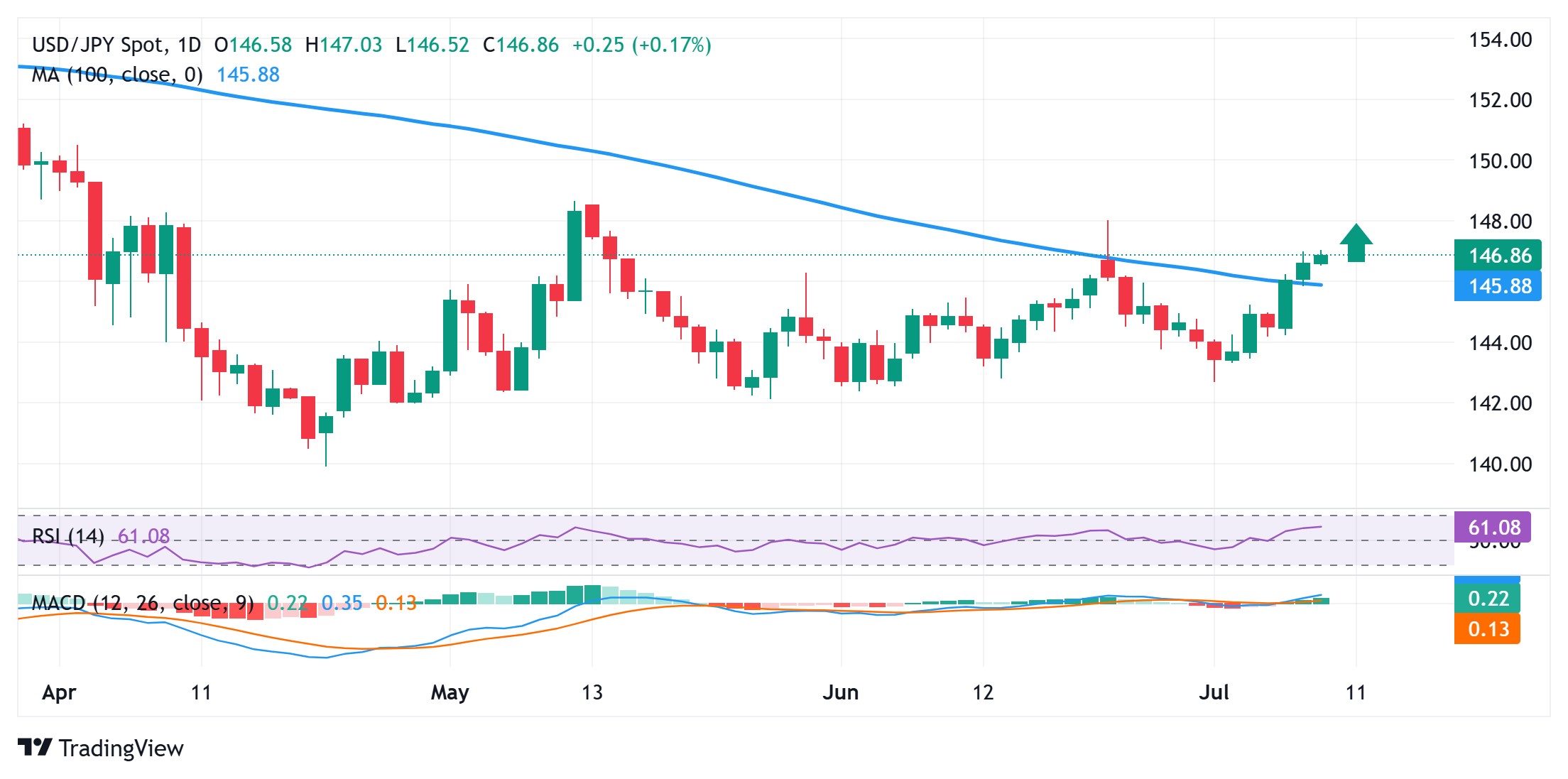Japanese Yen weakens on trade worries, pushing USD/JPY to fresh two-week highs
- The Japanese Yen continues losing ground amid worries about the economic impact of US tariffs.
- Domestic political uncertainty further undermine the JPY amid reduced BoJ rate hike bets.
- Diminishing odds for early Fed rate cuts act as a tailwind for the US Dollar and the USD/JPY pair.
The Japanese Yen (JPY) prolongs its weekly downtrend for the third successive day on Wednesday, pushing the USD/JPY pair to a fresh two-week high, around the 147.00 mark during the Asian session. Concerns about the economic fallout from US President Donald Trump's 25% tariffs from a new deadline of August 1 on Japanese goods undermine the JPY. Furthermore, expectations that trade tensions could create pressure on the Bank of Japan (BoJ) to forgo raising interest rates this year turn out to be another factor driving flows away from the JPY amid domestic political uncertainty.
Recent media polls have shown that the Liberal Democratic Party (LDP) and its junior ruling coalition partner Komeito may fail to secure a majority at the July 20 House of Councillors election. This could complicate trade negotiations and also heighten both fiscal and political risks in Japan, which favors the JPY bears. Furthermore, the recent US Dollar (USD) strength, bolstered by expectations that higher tariffs would underpin the US inflation and force the Federal Reserve (Fed) to hold off cutting interest rates, suggests that the path of least resistance for the USD/JPY pair is to the upside.
Japanese Yen bears retain short-term control as trade uncertainties temper Fed rate cut bets
- US President Donald Trump announced a 25% tariff on Japanese goods effective August 1 and warned that any retaliatory levies would draw a like-for-like response. Japanese Prime Minister Shigeru Ishiba said on Tuesday that bilateral talks would continue towards seeking a mutually beneficial trade deal.
- Nevertheless, trade tensions add to woes for Japan’s economy, which shrank in the first quarter on soft consumption. Adding to this, Japan's real wages in May fell at the fastest pace in 20 months. This backs the case for the Bank of Japan's caution in the near term, which is seen undermining the Japanese Yen.
- Recent surveys raised doubts about whether the ruling coalition of the Liberal Democratic Party (LDP) and Komeito will be able to secure enough seats in the upcoming House of Councillors election on July 20 to maintain their majority. This adds a layer of uncertainty and contributes to the JPY's downfall.
- The US Dollar, on the other hand, shot to a two-week high on Tuesday amid expectations that the Federal Reserve would keep interest rates elevated in anticipation of worsening inflation as a result of higher import taxes and a resilient US labor market. This lends additional support to the USD/JPY pair.
- The USD bulls, however, seem reluctant and opt to wait for more cues about the Fed's policy outlook before placing fresh bets. According to the CME Group's FedWatch tool, market participants are currently pricing in around 50 basis points of Fed rate cuts by the end of this year, starting in October.
- Hence, the focus remains glued to the release of FOMC meeting minutes, due later during the US session on Wednesday. Investors will look for fresh cues about the Fed's rate-cut path, which, in turn, will influence the USD price dynamics and provide a fresh impetus to the USD/JPY pair.
USD/JPY could extend momentum towards testing June swing high, around the 148.00 mark

The USD/JPY pair's overnight close above the 100-day Simple Moving Average (SMA) for the first time since February could be seen as a fresh trigger for bullish traders. Moreover, oscillators on the daily chart have been gaining positive traction and are still far from being in the overbought zone. The technical setup backs the case for a further near-term appreciating move towards the 147.60-147.65 intermediate hurdle en route to the 148.00 round figure, or the June monthly swing high.
On the flip side, the Asian session low, around the 146.50 area, now seems to protect the immediate downside. Any further corrective slide could be seen as a buying opportunity and remain limited near the 100-day SMA resistance breakpoint, currently pegged just below the 146.00 round figure. The latter should act as a key pivotal point, which if broken decisively might shift the near-term bias in favor of bearish traders and pave the way for some meaningful downside.
Tariffs FAQs
Tariffs are customs duties levied on certain merchandise imports or a category of products. Tariffs are designed to help local producers and manufacturers be more competitive in the market by providing a price advantage over similar goods that can be imported. Tariffs are widely used as tools of protectionism, along with trade barriers and import quotas.
Although tariffs and taxes both generate government revenue to fund public goods and services, they have several distinctions. Tariffs are prepaid at the port of entry, while taxes are paid at the time of purchase. Taxes are imposed on individual taxpayers and businesses, while tariffs are paid by importers.
There are two schools of thought among economists regarding the usage of tariffs. While some argue that tariffs are necessary to protect domestic industries and address trade imbalances, others see them as a harmful tool that could potentially drive prices higher over the long term and lead to a damaging trade war by encouraging tit-for-tat tariffs.
During the run-up to the presidential election in November 2024, Donald Trump made it clear that he intends to use tariffs to support the US economy and American producers. In 2024, Mexico, China and Canada accounted for 42% of total US imports. In this period, Mexico stood out as the top exporter with $466.6 billion, according to the US Census Bureau. Hence, Trump wants to focus on these three nations when imposing tariffs. He also plans to use the revenue generated through tariffs to lower personal income taxes.
